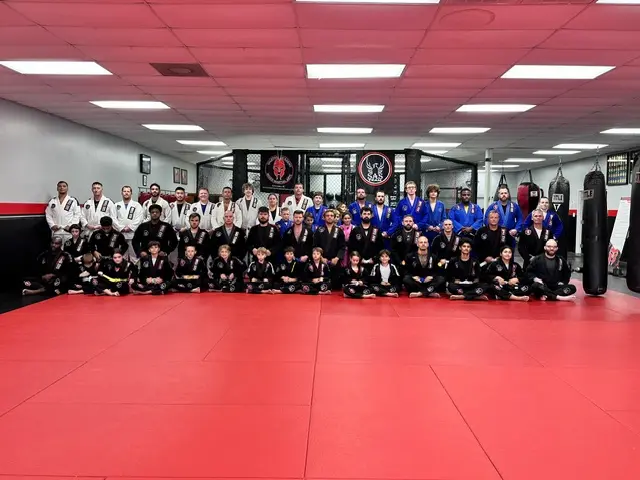Belt tying in martial arts involves centering the belt, wrapping it evenly, and securing a tight square knot to ensure safety, discipline, and a professional appearance during training.
Have you ever struggled with belt tying before stepping on the mat? Getting that knot right isn’t just about looks—it’s a key part of feeling confident and ready. Let’s unravel the simple art behind this essential skill.

Table of Contents
Toggleunderstanding the importance of proper belt tying in martial arts
Proper belt tying in martial arts is more than just tradition; it plays a crucial role in ensuring safety and respect. A well-tied belt keeps your uniform secure and prevents distractions during training or competitions.
Beyond functionality, the belt symbolizes your progress and dedication, reflecting the time and effort invested in mastering your art. Recognizing its importance can motivate practitioners to maintain discipline and enhance their focus.
Also, a neat belt knot shows respect for your instructors and fellow students, reinforcing the values of the martial arts culture. Understanding these reasons helps beginners appreciate the significance of learning to tie their belt correctly right from the start.
By embracing proper belt tying, you develop habits that contribute to confidence and presence, both on and off the mat.
step-by-step guide to tying your martial arts belt correctly
Learning a step-by-step guide to tying your martial arts belt correctly can make a big difference in your training routine. Follow these simple steps to achieve a secure and neat knot every time.
Step 1: Find the Center
Fold the belt in half to locate the center. Place the center of the belt just below your belly button.
Step 2: Wrap Around
Wrap both ends of the belt evenly around your waist, crossing them behind your back and bringing them back to the front.
Step 3: Cross in the Front
Cross the two ends in the front, ensuring the left side goes over the right side.
Step 4: Tuck Under
Take the top end and tuck it underneath both layers of the belt from bottom to top, pulling it through snugly.
Step 5: Tie the Knot
Make a simple square knot by crossing the two ends again: right over left, then left over right. Pull tightly to secure.
Practice these steps regularly to ensure your belt stays tied during intense movements and looks professional.
common mistakes beginners make when tying their belts
Many beginners make common mistakes when tying their martial arts belts that can affect both appearance and performance. One frequent error is not aligning the belt evenly around the waist, causing it to twist or hang unevenly.
Another mistake is tying the knot too loose, which can cause the belt to come undone during practice. A knot that’s too tight, however, may be uncomfortable and restrict movement.
Beginners often tie the knot incorrectly, such as using a granny knot instead of a square knot. This results in an unstable knot that easily slips.
Failing to center the belt before wrapping can also lead to imbalance, making it harder to keep the belt secure. Additionally, wearing the belt too long or letting it drag can cause damage and affect the belt’s integrity.
Being aware of these mistakes helps newcomers develop proper habits early on, making their training more comfortable and focused.
tips to keep your belt tight and looking professional during training
Keeping your martial arts belt tight and looking professional during training can boost your confidence and prevent distractions. One effective tip is to always start with a properly centered belt, making sure both ends are even before wrapping.
Use a firm, but comfortable knot that holds the belt securely without causing discomfort. Regularly adjust the belt during breaks to maintain tension and neatness.
Choosing the right belt size helps avoid excess length that can look sloppy or get in the way. Additionally, avoiding overly loose wraps and double-checking the knot’s tightness before training starts can make a significant difference.
Washing and caring for your belt properly also keeps it looking fresh and professional. Remember, a well-maintained belt reflects your discipline and respect for the martial arts tradition.
how mastering belt tying boosts your confidence and discipline
Mastering belt tying is a simple yet powerful skill that can significantly boost your confidence and discipline in martial arts. When you tie your belt correctly, you feel more prepared and focused, ready to face challenges on the mat.
Discipline grows as you learn the patience and precision needed to perfect your knot. This attention to detail carries over to other areas of your training and daily life.
A neat and secure belt symbolizes your progress and respect for the art, which reinforces a positive mindset. This boosts self-esteem and encourages continuous improvement.
Regular practice of belt tying also cultivates mindfulness, as it requires you to slow down and concentrate, fostering a stronger connection with your martial arts journey.
Why proper belt tying matters
Tying your martial arts belt correctly is a small skill with big benefits. It helps keep you safe, comfortable, and focused during training.
Practicing the right way builds discipline and confidence, showing respect for your art and yourself. Paying attention to details like belt tying sets the foundation for success both on and off the mat.
So, take the time to learn and master this essential skill. It’s more than just a knot – it’s part of your journey in martial arts.
FAQ – Common Questions About Martial Arts Belt Tying
Why is it important to tie my martial arts belt properly?
Proper belt tying ensures safety, comfort, and respect during training, helping you focus and perform better.
What is the best way to tie my martial arts belt?
Start by centering the belt on your waist, wrap evenly around, cross the ends in front, tuck one end under both layers, and finish with a square knot.
How tight should my belt be tied?
Your belt should be snug enough to stay in place during training but not so tight that it causes discomfort or restricts movement.
What are common mistakes to avoid when tying my belt?
Common mistakes include uneven wrapping, loose knots, tying the wrong type of knot, and not centering the belt properly.
How can I keep my belt looking neat during training?
Regularly adjust your belt during breaks, choose the correct belt size, avoid dragging, and maintain clean and cared-for gear.
Does mastering belt tying help outside the dojo?
Yes, mastering belt tying builds discipline, confidence, and focus that can positively influence other areas of your life.









